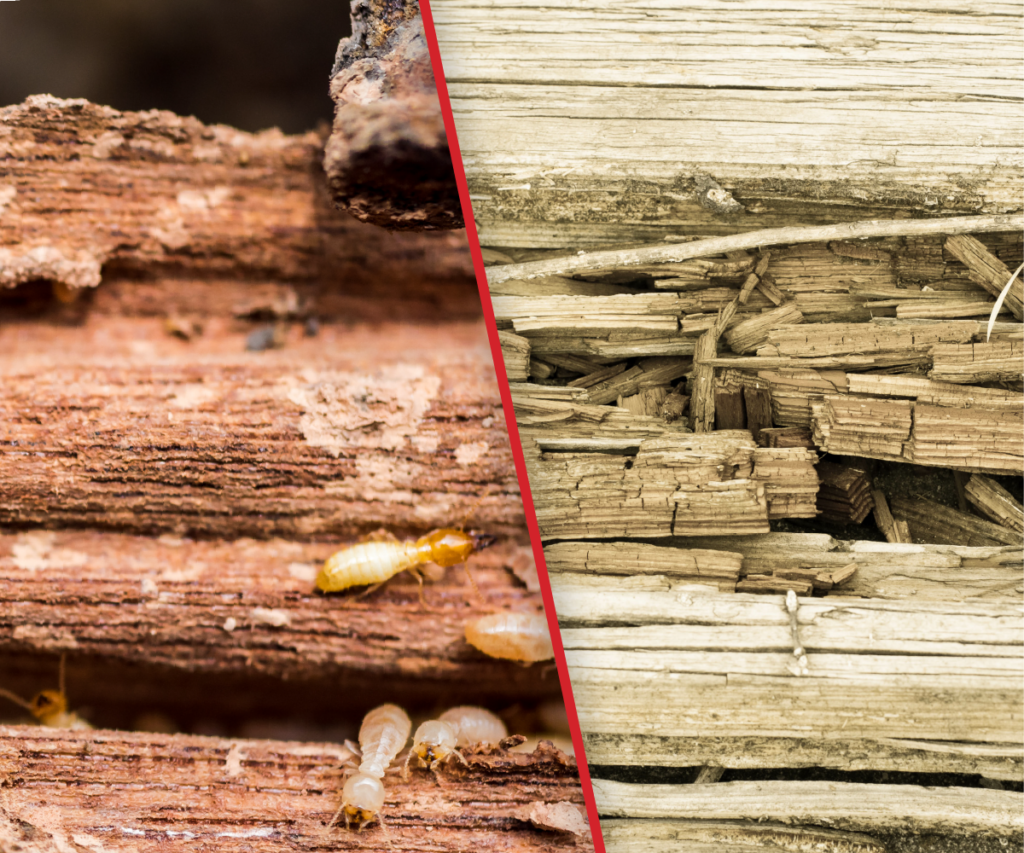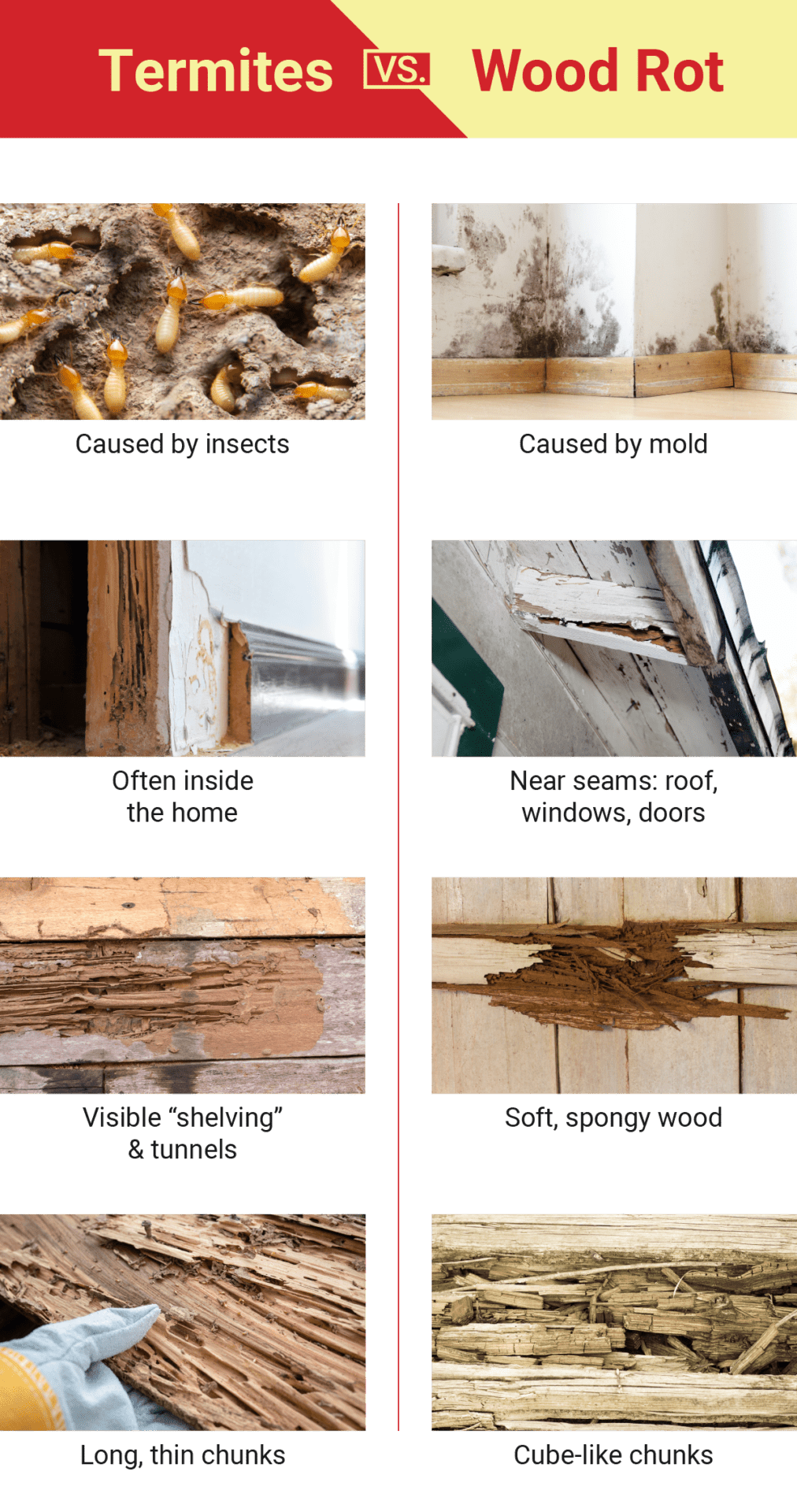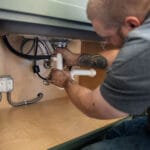Imagine waking up one morning, ready to tackle the day, only to discover a troubling sight in your home. Whether it’s sagging floors, peeling walls, or mysterious holes, the damage can be alarming.
You might wonder if your home is under attack by termites or suffering from water damage. Both can wreak havoc on your property, but knowing the difference is crucial for effective repair and prevention. You’ll uncover the telltale signs of termite damage versus water damage, and learn how each can affect your home.
Understanding these differences can save you time, stress, and money, ensuring your home remains a safe and comfortable space. Dive in to discover how to spot the signs and protect your sanctuary from these common household threats.

Credit: www.dodsonbros.com
Termite Damage Characteristics
Termite damage can be a silent invader, wreaking havoc on your home without you even realizing it. Unlike water damage, which often leaves obvious signs, termite damage is stealthy and can be difficult to detect. Understanding the characteristics of termite damage is crucial in safeguarding your property and avoiding costly repairs.
Signs Of Infestation
Have you noticed piles of wings near your windowsills? This could be an early sign of termite infestation. Termites shed their wings after swarming, leaving a clue for you to spot. Another indicator is the presence of mud tubes along your foundation or walls. Termites build these tubes to travel safely between their colony and food sources.
Common Areas Affected
Termites often target wooden structures in your home. They love to feast on beams, flooring, and walls. Pay close attention to areas with high moisture, like basements and bathrooms. Termites thrive in moist environments, making these areas vulnerable to their attack.
Visual Indicators
Can you see small holes or tunnels in wood? These are telltale signs of termite activity. Termites eat from the inside out, leaving hollowed-out wood that’s often difficult to see. Tap on suspect areas and listen for a hollow sound. If you notice wood that appears blistered or darkened, this might indicate termite damage.
Understanding these characteristics can help you take timely action. Have you ever had to deal with unexpected damage in your home? Identifying signs early could save you from extensive repairs. Keep an eye out and safeguard your home from these silent destroyers.

Credit: jwhomecare.com
Water Damage Characteristics
Distinguishing termite damage from water damage can be tricky. Termites usually leave hollow wood and mud tubes. Water damage often results in warped wood, stains, and mold. Recognizing these signs helps in addressing the right issue promptly.
Water damage can sneak up on you, sometimes even faster than you realize. Whether it’s a leaky roof, a burst pipe, or even the aftermath of a storm, water damage is something many homeowners dread. You might be surprised by how quickly it can spread, affecting different parts of your home in various ways. Understanding the characteristics of water damage can help you identify and address problems before they escalate.Causes And Sources
Water damage can originate from multiple sources. A few common ones include faulty plumbing, blocked gutters, and natural disasters like floods or heavy rainfall. Think of the last time you noticed a sudden increase in your water bill—could it have been a hidden leak? Even appliances like washing machines and dishwashers can be culprits. Regular maintenance and inspections can help you catch these issues early.Common Areas Affected
Water damage doesn’t discriminate; it can affect any part of your home. Basements are particularly vulnerable due to their proximity to groundwater. Kitchens and bathrooms, with their extensive plumbing, are also frequent victims. Have you ever noticed water stains on your ceiling? Attics can suffer from roof leaks, especially if they’re not properly insulated. Identifying these common areas can help you focus your efforts where they’re most needed.Visual Indicators
Spotting water damage early can save you a lot of trouble. Look for discoloration on walls or ceilings, a tell-tale sign that water has seeped in. Warped or buckling floors can indicate prolonged exposure to moisture. Have you ever walked into a room and noticed a musty smell? That could be mold, a common result of water damage. Regularly checking for these indicators can keep your home safe and dry. Have you ever dealt with unexpected water damage? What steps did you take to mitigate the issue? Your experience could help others facing similar challenges.Impact On Property Value
Termite damage often leads to structural issues, significantly lowering property value. Water damage can cause mold, impacting health and aesthetics. Both issues require costly repairs, affecting resale potential.
When considering the Impact on Property Value, both termite damage and water damage can significantly decrease the worth of a home. Imagine you’re about to buy a house. You step inside, only to find signs of structural damage. This instantly raises red flags. Homebuyers are often wary of properties with hidden issues. Understanding how these damages affect value is crucial. This knowledge can save you from costly mistakes.Long-term Effects
Termite damage can be sneaky. It often goes unnoticed until the damage is extensive. Over time, termites can weaken the foundation of a home. This can lead to major structural problems. Water damage, on the other hand, is usually more visible. However, it can cause mold and mildew growth. This not only affects health but also the integrity of the building materials. Both types of damage can make a property hard to sell.Repair Costs
Repairing termite damage can be quite costly. It often involves replacing wooden structures. You might also need professional pest control services. Water damage repair costs can vary. You might need to fix leaks, replace drywall, or deal with mold remediation. Both types of repairs add up quickly. And, they can deter potential buyers from making an offer. Consider a friend who bought a fixer-upper. They underestimated the repair costs. This mistake drained their renovation budget. Would you want to face the same situation? Understanding these impacts can guide you in property investment decisions. Always weigh the long-term effects and repair costs. This insight can protect your investment and future resale value.
Credit: www.dodsonbros.com
Prevention Techniques
Both termite and water damage can wreak havoc on a home. Effective prevention includes regular inspections for termites and fixing leaks promptly. Using treated wood and ensuring proper drainage also helps protect against these threats.
Preventing damage to your home from termites and water is crucial for maintaining its value and safety. Both types of damage can be costly and time-consuming to repair. By implementing effective prevention techniques, you can save yourself a lot of trouble. Imagine coming home to find your walls crumbling due to termites or your basement flooded. It’s not a scenario anyone wants to face. Let’s look at some practical strategies to keep your home safe.Preventing Termite Damage
First, ensure your home is not providing an easy buffet for termites. Keep wood piles and debris away from the foundation of your house. Termites thrive in moist and dark environments, so addressing these conditions is key. Regular inspections are a must. Schedule annual termite inspections with a professional. Early detection can save you thousands in repairs. Consider using termite-resistant materials if you’re building or renovating. Steel, concrete, or treated wood are less attractive to these pests. Seal any cracks or crevices in your home’s foundation. These tiny openings can be entry points for termites. A little caulk can go a long way.Preventing Water Damage
Start by checking your gutters and downspouts. Ensure they’re clean and directing water away from your home. A clogged gutter can lead to water overflow and damage. Inspect your roof regularly for missing or damaged shingles. A small leak can cause significant damage over time. Fixing a shingle is much cheaper than replacing a ceiling. Basement waterproofing is a smart investment if you live in a flood-prone area. Consider installing a sump pump to keep water at bay. Don’t forget about your plumbing. Regularly check for leaks under sinks and around appliances. A dripping pipe can lead to mold and structural damage over time. How do you currently protect your home? What’s one small step you can take today to ensure it stays safe from termites and water damage? Taking action now can prevent major headaches later.Repair And Restoration
Repairing and restoring damage caused by termites or water is crucial. Both damages can lead to severe structural issues if ignored. Understanding the restoration process helps in choosing the right approach. Effective repair ensures the safety and longevity of your home.
Termite Damage Restoration
Termite damage restoration begins with a thorough inspection. Identifying all affected areas is key. Once located, remove damaged wood and replace it with new materials. Professionals often use treated wood to prevent future infestations. It’s essential to treat the surrounding area with pesticides. This prevents termites from returning. Regular inspections help maintain a termite-free environment.
Water Damage Restoration
Water damage restoration starts by stopping the water source. Drying out the area is the next step. This prevents mold growth and further damage. Use dehumidifiers and fans to speed up drying. Replace water-damaged materials like drywall and carpeting. Cleaning and sanitizing the area is essential. This removes bacteria and ensures a safe environment. Regular maintenance prevents future water damage.
Professional Inspection
Termite damage and water damage can seriously harm your home. Each type has unique signs and repair needs. Recognizing the difference early can save costs and prevent further issues.
When it comes to safeguarding your home, understanding the distinct signs of termite damage versus water damage is vital. While both can wreak havoc on your property, pinpointing the cause is crucial for effective repair. This is where professional inspection comes into play. Experts have the skills and tools to accurately identify and differentiate between these two types of damage. This knowledge can save you time, money, and further stress.When To Call Experts
You might wonder when is the right time to bring in the professionals. If you notice sagging floors, discolored walls, or strange smells, these could be red flags. Don’t wait for the damage to worsen; early intervention can prevent costly repairs. It’s better to have a professional inspection sooner rather than later. Remember, when in doubt, it’s always safer to call in an expert.Inspection Process
The inspection process is detailed and methodical, focusing on detecting the root cause of damage. Professionals will assess areas like the foundation, walls, and ceilings. They use specialized tools to look for termite galleries or moisture patterns. You’ll receive a comprehensive report outlining their findings and recommendations. This empowers you to make informed decisions about repairs and maintenance. Professional inspectors also provide peace of mind. They offer insights that you might miss on your own. Their expert opinion can guide you in choosing the best course of action. So, have you considered how a professional inspection might benefit your home? It could be the key to preserving your property’s value and safety.Frequently Asked Questions
How Can You Identify Termite Damage?
Look for hollow wood, mud tubes, and discarded wings. Check for weak or damaged wood structures.
What Are Signs Of Water Damage In A Home?
Stains, dampness, and mold growth are signs. Also, peeling paint and warped floors.
Can Termites Cause Structural Damage?
Yes, termites can weaken wooden structures. This may lead to serious safety concerns.
Is Water Damage More Costly Than Termite Damage?
It depends on severity and area affected. Both can be expensive to repair.
How Do You Prevent Termite And Water Damage?
Regular inspections help. Fix leaks and remove wood debris to deter termites.
Conclusion
Understanding termite and water damage is crucial for homeowners. Both can harm your home. Termites silently eat wood, causing structural issues. Water damage leads to mold and weakens materials. Regular inspections help identify risks early. Preventive measures save money and stress.
Always address signs of damage promptly. Protect your home investment. Awareness and action are key. Consider professional help for repairs. Safety and home value depend on it. Stay informed and proactive. Your home deserves care and attention.




